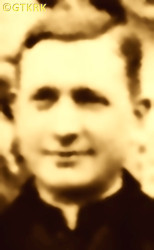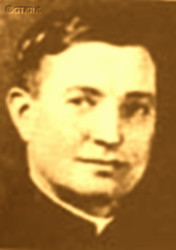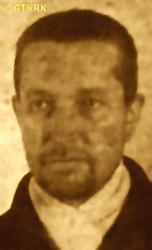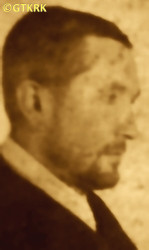Roman Catholic
St Sigismund parish
05-507 Słomczyn
85 Wiślana Str.
Konstancin deanery
Warsaw archdiocese, Poland
full list:
displayClick to display full list

searchClick to search full list by categories
wyświetlKliknij by wyświetlić pełną listę po polsku

szukajKliknij by przeszukać listę wg kategorii po polsku

Martyrology of the clergy — Poland
XX century (1914 – 1989)
personal data
surname
ŻDAN
forename(s)
John (pl. Jan)

function
eparchial priest
creed
Ukrainian Greek Catholic GCmore on
en.wikipedia.org
[access: 2013.05.19]
diocese / province
Lviv GC archeparchymore on
en.wikipedia.org
[access: 2013.05.19]
nationality
Ukrainian
date and place
of death
29.07.1944

ITL VorkutLagGuLAG slave labour camp network
today: Komi rep., Russia
more on
en.wikipedia.org
[access: 2022.01.09]
details of death
After German and Russian invasion of Poland in 09.1939 and start of World War II, after the beginning of the Russian occupation, after the closure of the gymnasiums where he taught by the Russians, taught catechesis in his parish.
Arrested by the Russians 12(22).09.1940 (according to other sources in 1941). Allegedly accused of collaborating with the genocidal Ukrainian organization OUN.
On 12.05.1941, tried by the Russian genocidal NKVD kangaroo court. Sentenced to 8 years of forced slave labor in Russian Gulag concentration camps.
Right before (or just after) the German attack on 22.06.1941 on their erstwhile ally, the Russians, and the Russian panic escape to the east, transported to the Starobilsk concentration camp.
From there taken to the ITL VorkutLag concentration camp in the Komi Republic, in northern Russia.
Prob. was not covered by the Sikorski–Majski Agreement of 30.07.1941, signed by the Polish government and communist Russia after the above–mentioned German attack on the Russians, which, among other things, provided for the release of all Polish citizens arrested by the Russians in the years 1939‐1941 during the occupation of part of Poland — on 01.12.1941, the Russians issued a regulation that excluded from this „amnesty”, among others, Polish citizens of „Rusyn nationality”.
Perished in VorkutŁag camp after a few years, in unknown circumstances.
cause of death
extermination
perpetrators
Russians
sites and events
ITL VorkutLagClick to display the description, GulagClick to display the description, KLW StarobilskClick to display the description, «Genocidium Atrox»Click to display the description, Ribbentrop‐MolotovClick to display the description, Pius XI's encyclicalsClick to display the description
date and place
of birth
1900

Krowica Samatoday: Lubaczów gm., Lubaczów pov., Subcarpathia voiv., Poland
more on
en.wikipedia.org
[access: 2023.12.01]
presbyter (holy orders)
ordination
1931

positions held
till c. 1940
vicar — Lvivtoday: Lviv urban hrom., Lviv rai., Lviv obl., Ukraine
more on
en.wikipedia.org
[access: 2022.01.16] ⋄ Assumption of the Blessed Virgin Mary GC parish ⋄ Lvivtoday: Lviv urban hrom., Lviv rai., Lviv obl., Ukraine
more on
en.wikipedia.org
[access: 2022.01.16] GC deanery
1933 – c. 1939
prefect — Lvivtoday: Lviv urban hrom., Lviv rai., Lviv obl., Ukraine
more on
en.wikipedia.org
[access: 2022.01.16] ⋄ GC parish — i.a. in Basilian Nuns’ Private Gymnasium for Girls (till 1939), Ukrainian Academic Gymnasium (1935‐1939), Greek Catholic Lower Theological Seminary (1933‐1935)
1931 – 1933
vicar — Sorotsketoday: Sorotske hrom., Ternopil rai., Ternopil obl., Ukraine
more on
uk.wikipedia.org
[access: 2022.08.05] ⋄ Intercession of the Blessed Virgin Mary GC parish ⋄ Skalattoday: Skalat urban hrom., Ternopil rai., Ternopil obl., Ukraine
more on
en.wikipedia.org
[access: 2020.11.15] GC deanery
c. 1927 – c. 1931
student — Lvivtoday: Lviv urban hrom., Lviv rai., Lviv obl., Ukraine
more on
en.wikipedia.org
[access: 2022.01.16] ⋄ philosophy and theology, Greek Catholic Theological Seminary
sites and events
descriptions
ITL VorkutLag: Russian Rus. Исправи́тельно‐Трудово́й Ла́герь (Eng. Corrective Labor Camp) ITL Rus. Воркутинский (Eng. Vorkutinskiy) — concentration and slave forced labor camp (within the Gulag complex) — headquartered in the town of Vorkuta in the Republic of Komi (initially prob. in Arkhangelsk Oblast), beyond the Arctic circle. Founded on 10.05.1938. Prisoners slaved at the construction of mines and coal mining (including processing plants, construction and renovation of access railway lines), preparation for industrial purposes and development of molybdenum deposits (including construction of the Vorkuta‐Kharbey power line, experimental enrichment plant, access roads), construction of barges on the Pechora River, construction of a thermal power plant, in various factories (production of bricks, building materials, wood processing, cement, furs, consumer goods), workshops (repair, mechanical), auxiliary agricultural work, etc. At its peak — till the death on 05.03.1953 of Russian socialist leader, Joseph Stalin — c. 73,000 prisoners were held there: e.g. 52,195 (01.01.1946); 62,525 (01.01.1948); 62,676 (01.01.1950); 72,940 (01.01.1951); 41,677 (01.01.1952); 52,453 (01.01.1955); 50,515 (01.01.1956); 49,646 (01.01.1957). In the most tragic year in the history of the camp, 1943, 15.5% of prisoners died. The total number of victims is unknown. Ceased to exist in 1960. (more on: old.memo.ruClick to attempt to display webpage
[access: 2024.04.08])
Gulag: The acronym Gulag comes from the Rus. Главное управление исправительно‐трудовых лагерей и колоний (Eng. Main Board of Correctional Labor Camps). The network of Russian concentration camps for slave labor was formally established by the decision of the highest Russian authorities on 27.06.1929. Control was taken over by the OGPU, the predecessor of the genocidal NKVD (from 1934) and the MGB (from 1946). Individual gulags (camps) were often established in remote, sparsely populated areas, where industrial or transport facilities important for the Russian state were built. They were modeled on the first „great construction of communism”, the White Sea‐Baltic Canal (1931‐1932), and Naftali Frenkel, of Jewish origin, is considered the creator of the system of using forced slave labor within the Gulag. He went down in history as the author of the principle „We have to squeeze everything out of the prisoner in the first three months — then nothing is there for us”. He was to be the creator, according to Alexander Solzhenitsyn, of the so‐called „Boiler system”, i.e. the dependence of food rations on working out a certain percentage of the norm. The term ZEK — prisoner — i.e. Rus. заключенный‐каналоармец (Eng. canal soldier) — was coined in the ITL BelBaltLag managed by him, and was adopted to mean a prisoner in Russian slave labor camps. Up to 12 mln prisoners were held in Gulag camps at one time, i.e. c. 5% of Russia's population. In his book „The Gulag Archipelago”, Solzhenitsyn estimated that c. 60 mln people were killed in the Gulag until 1956. Formally dissolved on 20.01.1960. (more on: en.wikipedia.orgClick to attempt to display webpage
[access: 2024.04.08])
KLW Starobilsk: Russian Rus. Концентрационный Лагерь для Военнопленных (Eng. POW Concentration Camp) KLW, run by genocidal Russian NKVD organization, for Poles arrested after the invasion in 1939, operating in 1939‐1940 in Starobilsk — on the premises of the „All Afflicted Joy” Icon of Our Lady Orthodox monastery, looted and closed by Russian Bolsheviks in 1923. In 04.1940 c. 3,800 were kept there (in 11.1939 — 11,262) — per captive there was c. 1.25 m2 of bunk space on which they had to sleep, eat and keep their belongings, initially the receiving only one meal a day. Subsequently— as the fulfillment of Russian government decision to exterminate Polish intelligentsia and prisoners of war camps (Polish holocaust) — were executed in Kharkiv. Among the victims were 8 generals, 55 colonels, 127 lieutenant colonels, 230 majors, c. 1,000 captains, and c. 2,450 lieutenants and second lieutenants of the Polish Army. Almost half were reserve officers: over 20 professors of universities, all without exception scientific staff of the Anti‐Gas Institute of the Polish Army and almost the entire staff of the Institute of Armament of the Polish Army, c. 400 doctors, several hundred lawyers, several hundred engineers, c. 100 teachers, c. 600 pilots , many social activists, several dozen writers and journalists. Used as a concentration camp for Poles later as well. (more on: pl.wikipedia.orgClick to attempt to display webpage
[access: 2012.11.23])
«Genocidium Atrox»: In 1939‐1947, especially in 1943‐1944, independent Ukrainian units, mainly belonging to genocidal Ukrainian organizations OUN (political arm) and UPA (military arm), supported by local Ukrainian population, murdered — often in extremely brutal way — in Volyn and surrounding regions of pre‐war Poland, from 130,000 to 180,000 Poles, all civilians: men, women, children, old and young. Polish‐Ukrainian conflict that openly emerged during and after World War I (in particular resulting in Polish‐Ukrainian war of 1918‐1919), that survived and even deepened later when western Ukraine became a part Poland, exploded again after the outbreak of the World War II in 09.1939. During Russian occupation of 1939‐1941, when hundreds of thousands of Poles were deported into central Russia, when tens of thousands were murdered (during so‐called Katyń massacres, among others), this open conflict had a limited character, helped by the fact that at that time Ukrainians, Ukrainian nationalists in particular, were also persecuted by the Russians. The worst came after German‐Russian war started on 22.06.1941 and German occupation resulted. Initially Ukrainians supported Germans (Ukrainian police was initiated, Ukrainians co—participated in extermination of the Jews and were joining army units fighting alongside Germans). Later when German ambivalent position towards Ukraine became apparent Ukrainians started acting independently. And in 1943 one of the units of aforementioned Ukrainian OUN/UPA organization, in Volyn, started and perpetrated a genocide of Polish population of this region. In mere few weeks OUN/UPA murdered, with Germans passively watching on the sidelines, more than 40,000 Poles. This strategy was consequently approved and adopted by all OUN/UPA organisations and similar genocides took place in Eastern Lesser Poland (part of Ukraine) where more than 20,000 Poles were slaughtered, meeting however with growing resistance from Polish population. Further west, in Chełm, Rzeszów, etc. regions this genocide turned into an extremely bloody conflict. In general genocide, perpetrated by Ukrainian nationalists, partly collaborating with German occupants, on vulnerable Polish population took part in hundreds of villages and small towns, where virtually all Polish inhabitants were wiped out. More than 200 priests, religious and nuns perished in this holocaust — known as «Genocidium Atrox» (Eng. „savage genocide”) The nature and purpose of genocide is perhaps best reflected in the song sung by the murderers: „We will slaughter the Poles, we will cut down the Jews, we must conquer the great Ukraine” (ukr. „Поляків виріжем, Євреїв видусим, велику Україну здобути мусим”). This holocaust and conflict ended up in total elimination of Polish population and Polish culture from Ukraine, in enforced deportations in 1944‐1945 of remaining Poles from Ukraine and some Ukrainians into Ukraine proper, and finally in deportation of Ukrainians from East‐South to the Western parts of Polish republic prl by Commie‐Nazi Russian controlled Polish security forces („Vistula Action”). (more on: www.swzygmunt.knc.plClick to attempt to display webpage
[access: 2021.06.20])
Ribbentrop‐Molotov: Genocidal Russian‐German alliance pact between Russian leader Joseph Stalin and German leader Adolf Hitler signed on 23.08.1939 in Moscow by respective foreign ministers, Mr. Vyacheslav Molotov for Russia and Joachim von Ribbentrop for Germany. The pact sanctioned and was the direct cause of joint Russian and German invasion of Poland and the outbreak of the World War II in 09.1939. In a political sense, the pact was an attempt to restore the status quo ante before 1914, with one exception, namely the „commercial” exchange of the so‐called „Kingdom of Poland”, which in 1914 was part of the Russian Empire, fore Eastern Galicia (today's western Ukraine), in 1914 belonging to the Austro‐Hungarian Empire. Galicia, including Lviv, was to be taken over by the Russians, the „Kingdom of Poland” — under the name of the General Governorate — Germany. The resultant „war was one of the greatest calamities and dramas of humanity in history, for two atheistic and anti‐Christian ideologies — national and international socialism — rejected God and His fifth Decalogue commandment: Thou shall not kill!” (Abp Stanislav Gądecki, 01.09.2019). The decisions taken — backed up by the betrayal of the formal allies of Poland, France and Germany, which on 12.09.1939, at a joint conference in Abbeville, decided not to provide aid to attacked Poland and not to take military action against Germany (a clear breach of treaty obligations with Poland) — were on 28.09.1939 slightly altered and made more precise when a treaty on „German‐Russian boundaries and friendship” was agreed by the same murderous signatories. One of its findings was establishment of spheres of influence in Central and Eastern Europe and in consequence IV partition of Poland. In one of its secret annexes agreed, that: „the Signatories will not tolerate on its respective territories any Polish propaganda that affects the territory of the other Side. On their respective territories they will suppress all such propaganda and inform each other of the measures taken to accomplish it”. The agreements resulted in a series of meeting between two genocidal organization representing both sides — German Gestapo and Russian NKVD when coordination of efforts to exterminate Polish intelligentsia and Polish leading classes (in Germany called «Intelligenzaktion», in Russia took the form of Katyń massacres) where discussed. Resulted in deaths of hundreds of thousands of Polish intelligentsia, including thousands of priests presented here, and tens of millions of ordinary people,. The results of this Russian‐German pact lasted till 1989 and are still in evidence even today. (more on: en.wikipedia.orgClick to attempt to display webpage
[access: 2015.09.30])
Pius XI's encyclicals: Facing the creation of two totalitarian systems in Europe, which seemed to compete with each other, though there were more similarities than contradictions between them, Pope Pius XI issued in 03.1937 (within 5 days) two encyclicals. In the „Mit brennender Sorge” (Eng. „With Burning Concern”) published on 14.03.1938, condemned the national socialism prevailing in Germany. The Pope wrote: „Whoever, following the old Germanic‐pre‐Christian beliefs, puts various impersonal fate in the place of a personal God, denies the wisdom of God and Providence […], whoever exalts earthly values: race or nation, or state, or state system, representatives of state power or other fundamental values of human society, […] and makes them the highest standard of all values, including religious ones, and idolizes them, this one […] is far from true faith in God and from a worldview corresponding to such faith”. On 19.03.1937, published „Divini Redemptoris” (Eng. „Divine Redeemer”), in which criticized Russian communism, dialectical materialism and the class struggle theory. The Pope wrote: „Communism deprives man of freedom, and therefore the spiritual basis of all life norms. It deprives the human person of all his dignity and any moral support with which he could resist the onslaught of blind passions […] This is the new gospel that Bolshevik and godless communism preaches as a message of salvation and redemption of humanity”… Pius XI demanded that the established human law be subjected to the natural law of God , recommended the implementation of the ideal of a Christian state and society, and called on Catholics to resist. Two years later, National Socialist Germany and Communist Russia came together and started World War II. (more on: www.vatican.vaClick to attempt to display webpage
[access: 2023.05.28], www.vatican.vaClick to attempt to display webpage
[access: 2023.05.28])
sources
personal:
100krokiv.infoClick to attempt to display webpage
[access: 2023.12.01], ru.openlist.wikiClick to attempt to display webpage
[access: 2023.12.01], biographies.library.nd.eduClick to attempt to display webpage
[access: 2014.11.14]
original images:
photo-lviv.in.uaClick to attempt to display webpage
[access: 2023.12.01], www.russiacristiana.orgClick to attempt to display webpage
[access: 2014.12.20], 100krokiv.infoClick to attempt to display webpage
[access: 2023.12.01], 100krokiv.infoClick to attempt to display webpage
[access: 2023.12.01]
LETTER to CUSTODIAN/ADMINISTRATOR
If you have an Email client on your communicator/computer — such as Mozilla Thunderbird, Windows Mail or Microsoft Outlook, described at WikipediaPatrz:
en.wikipedia.org, among others — try the link below, please:
LETTER to CUSTODIAN/ADMINISTRATORClick and try to call your own Email client
If however you do not run such a client or the above link is not active please send an email to the Custodian/Administrator using your account — in your customary email/correspondence engine — at the following address:

giving the following as the subject:
MARTYROLOGY: ŻDAN John
To return to the biography press below:
 Click to return to biography
Click to return to biography











